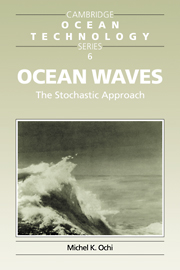Book contents
- Frontmatter
- Contents
- Preface
- 1 Description of random seas
- 2 Spectral analysis
- 3 Wave amplitude and height
- 4 Wave height and associated period
- 5 Sea severity
- 6 Estimation of extreme wave height and sea state
- 7 Directional characteristics of random seas
- 8 Special wave events
- 9 Non-Gaussian waves (waves in finite water depth)
- Appendix A Fundamentals of probability theory
- Appendix B Fundamentals of stochastic process theory
- Appendix C Fourier transform and Hilbert transform
- References
- Index
4 - Wave height and associated period
Published online by Cambridge University Press: 15 October 2009
- Frontmatter
- Contents
- Preface
- 1 Description of random seas
- 2 Spectral analysis
- 3 Wave amplitude and height
- 4 Wave height and associated period
- 5 Sea severity
- 6 Estimation of extreme wave height and sea state
- 7 Directional characteristics of random seas
- 8 Special wave events
- 9 Non-Gaussian waves (waves in finite water depth)
- Appendix A Fundamentals of probability theory
- Appendix B Fundamentals of stochastic process theory
- Appendix C Fourier transform and Hilbert transform
- References
- Index
Summary
INTRODUCTION
For a complete description of wind-generated random waves, it is necessary to consider wave height and period as well as the direction of travel. In particular, serious consideration must be given to the combined effect of height, period and direction, if any correlation exists. Wave data measured in the ocean show that period dispersion for very large wave height is not widely spread; as is also the case of height dispersion for large wave periods. In other words, height and period of incident waves are not statistically independent. Hence, the joint probability distribution of wave height and period plays a significant role in predicting statistical properties of waves such as the frequency of occurrence of wave breaking in a seaway.
Wave breaking takes place when wave height and period cannot maintain the equilibrium condition needed for stability. Therefore, for estimating the possibility of the occurrence of wave breaking in a given sea condition, knowledge of statistics on wave height and associated period, namely, the joint probability distribution, is necessary.
Further, the joint probability distribution of wave height and period is of the utmost importance for the design of floating marine systems. This is because one of the most important considerations for the design of a floating marine system lies in estimation of the possible occurrence of resonant motion which may occur when wave periods are close to the natural motion period of the system.
- Type
- Chapter
- Information
- Ocean WavesThe Stochastic Approach, pp. 103 - 122Publisher: Cambridge University PressPrint publication year: 1998



